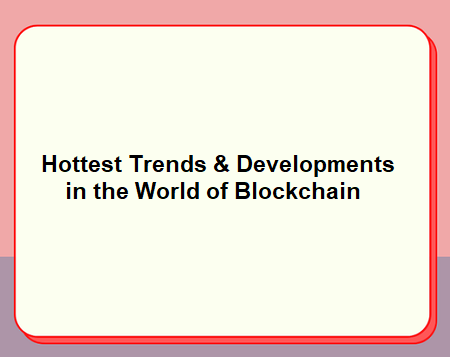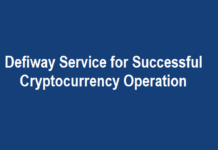
In the ever-changing environment of technology, blockchain has emerged as a groundbreaking innovation. It’s a decentralized and transparent system that’s poised to transform various industries, reshaping how we conduct business, manage information, and even govern. Over the past ten years, blockchain technology has advanced and matured, with a multitude of trends and developments forging the path toward a decentralized era. In this article, we’ll delve into some of the most exciting trends and progressions in blockchain, highlighting its transformative capabilities and the opportunities it offers.
DeFi (Decentralized Finance) – Democratizing Finance
Decentralized Finance, or DeFi, is a key trend in the blockchain arena. Utilizing blockchain’s inherent transparency and smart contracts, DeFi platforms offer financial services without middlemen, granting global users access to lending, borrowing, trading, and earning potentials. DeFi allows anyone with internet access to engage in the worldwide financial system, irrespective of location or socio-economic standing.
Recently, we’ve seen the introduction of DeFi 2.0. DeFi 2.0 represents the next phase of evolution in the DeFi ecosystem, aimed at addressing the risks associated with DeFi transactions. This includes mitigating cryptocurrency volatility by introducing insurance mechanisms to protect liquidity providers from losses caused by price fluctuations.
Additionally, it enhances smart contract security by incorporating insurance coverage for potential vulnerabilities and requiring open-source communities or insurance companies to conduct security assessments on smart contracts. With a focus on accountability, DeFi 2.0 aims to safeguard lenders from losses due to borrower defaults. These improvements create a more secure and reliable DeFi environment, fostering confidence and trust among users and promoting further adoption in the decentralized finance space.
Key Insights into DeFi:
- Yield Farming: Gaining rewards by supplying liquidity to DeFi protocols.
- Automated Market Makers (AMMs): Algorithm-driven pricing for trading assets, avoiding conventional order books.
- Stablecoins: Cryptocurrencies anchored to solid assets like the US dollar, mitigating volatility and boosting practicality.
NFTs (Non-Fungible Tokens) – A New Age of Ownership and Digital Creativity
NFTs have revolutionized the art and digital media landscape, presenting a novel way to confirm ownership and genuineness of digital assets. NFTs are distinct and symbolize unique entities like digital art, virtual property, and collectibles. Artists and creators can directly profit from their digital works, changing the dynamics of the art market and enabling enthusiasts to back their preferred artists.
Noteworthy NFT Movements:
- Virtual Real Estate: Ownership and trade of virtual land in blockchain-based online realms.
- Gaming and Entertainment: In-game assets and virtual goods symbolized as NFTs.
- Digital Identity: Utilizing NFTs as digital ID cards to affirm identity and avail services.
Interoperability – Unifying Blockchains for Smooth Transactions
As blockchain networks multiply, interoperability becomes vital. It refers to the capacity of varying blockchain systems to interact and exchange information, assets, and smart contracts. Initiatives like Polkadot, Cosmos, and ICON are striving to fashion a multi-chain environment where disparate blockchains can cooperate effectively, augmenting scalability, speed, and versatility.
Advantages of Interoperability:
- Facilitation of cross-chain dealings and asset movement.
- Mitigation of network traffic and scalability enhancement.
- Fostering cooperation and originality among diverse blockchain projects.
Layer 2 Solutions – Expanding Blockchain for Widespread Usage
Scalability is a continual obstacle for blockchain technology. Layer 2 solutions intend to tackle this by processing transactions more efficiently without compromising the security of the primary blockchain. Examples like Bitcoin’s Lightning Network and Ethereum’s rollup solutions illustrate how Layer 2 improves blockchain’s abilities and throughput.
Layer 2 Scaling Benefits:
- Swift and economical transactions, lessening main chain congestion.
- Enhanced user interface, fostering extensive acceptance of blockchain apps.
- Reduction in environmental footprint by lowering energy use.
Central Bank Digital Currencies (CBDCs) – The Advent of State-Sanctioned Digital Money
Governments globally are investigating Central Bank Digital Currencies (CBDCs) as a way to update financial structures and enhance international transactions. CBDCs are electronic renditions of domestic currencies, supervised and standardized by central banks. Unlike traditional cryptocurrencies, CBDCs are centrally managed and are meant to supplement, not supplant, regular fiat money.
CBDC Advantages:
- Speedier and more streamlined international transactions.
- Broadened financial accessibility and banking service availability.
- Refined execution and oversight of monetary policies.
Conclusion: Toward a Decentralized Horizon
As we examine the hottest innovations and movements in the blockchain universe, it’s clear that this technology is catalyzing unmatched innovation and sector disruption. From decentralized finance to unique tokens and interoperability solutions, blockchain is inaugurating a new epoch of confidence, openness, and effectiveness.
The blockchain voyage is merely commencing, and the potential for influential change is vast. As blockchain keeps evolving and permeating various life facets, we must seize the opportunities it presents, while concurrently addressing its challenges. Through synergy, regulation, and consumer-oriented solutions, we can sculpt a decentralized future that strengthens individuals and global communities.











